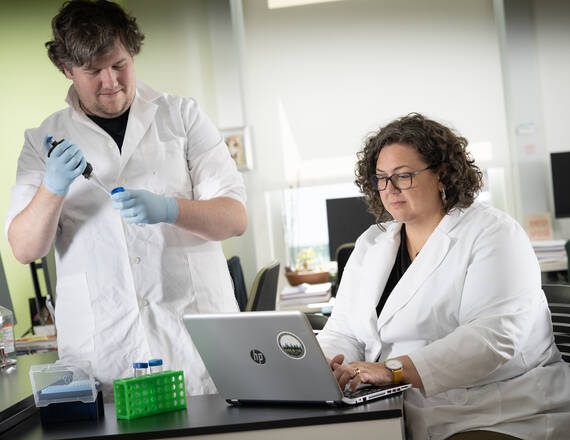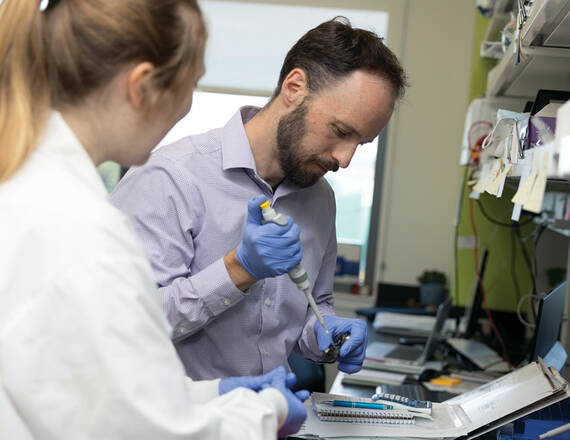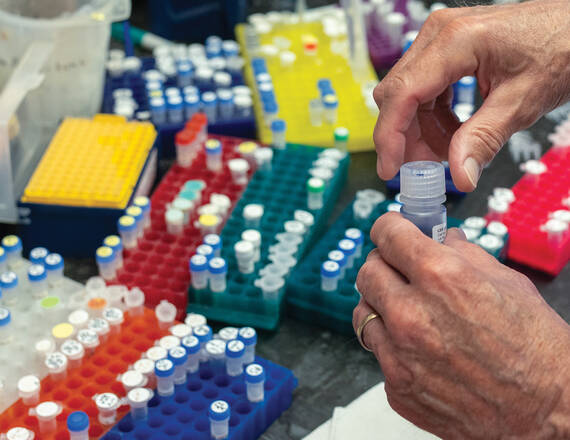Piloting to the Moon: How Two Biomedical Engineers are Reimagining Cancer Surgeries
Community-raised Prouty Pilot seed funding prepared researchers to receive up to $31.3 million in Cancer Moonshot funding
While The Prouty was breaking a new fundraising record in 2023, Dartmouth Cancer Center biomedical engineers Kimberley Samkoe, PhD, and Samuel Streeter, PhD, were applying for some of that funding. Their goal? To pioneer a new fluorescence imaging technique that helps cancer surgeons avoid healthy nerves during lifesaving surgeries.
These so-called Prouty “Pilot Projects” have proven critical for getting promising projects off the ground, and for seeding subsequent larger-scale funding from the National Institutes of Health (NIH) and other organizations.
Before teaming up for the Prouty Pilot, Samkoe, an associate professor of engineering and a Translational Engineering in Cancer Research Program member, had never collaborated with Streeter, a Dartmouth Health assistant professor of orthopaedics. But Dartmouth’s right-sized environment to foster new connections made it easy for Samkoe and Streeter to build a lasting partnership.

The Launching Pad
Originally from Saskatchewan, Canada, Samkoe started as a biochemist. She came to Dartmouth’s Thayer School of Engineering 17 years ago as a postdoctoral fellow in biomedical engineering, and later joined the Cancer Center faculty. Her focus today is on proteins and their role in cancer.
Proteins are essential to the healthy growth and function of the more than 1 trillion cells in the human body. But sometimes, mutations or other changes can shift proteins’ normal activity into hyperdrive. When this happens, cells will begin to grow out of control, which can sometimes lead to cancer.
In her lab, Samkoe uses fluorescence imaging to shine a light on this behavior. Simply put, this technique allows her to assign different light wavelengths to different proteins—which she calls molecular agents—in both healthy and cancerous tissue.
“The colors of the light … can be separated and used to indicate the molecular agent that we’re looking for,” says Samkoe. “I call this ‘illuminating oncology’ because we try to make cancer easier to see in different ways.”
The Pilot
For their Prouty Pilot, Samkoe and Streeter wanted to show that both tumors and nerves can be imaged distinctly and simultaneously with fluorescence, helping surgeons distinguish between the two.
After securing their Prouty Pilot grant, the researchers initiated safety and efficacy studies, with larger-scale, NIH-funded clinical trials on the horizon. “Our goal as biomedical engineers is to achieve clinical translation of our developed technologies. We’re looking to take scientific discoveries into the clinical setting to improve both the patient and clinician experience,” Samkoe says.
The Moon
With these Pilot Projects well underway, it came as wonderful news in August 2024 when the federal Advanced Research Projects Agency for Health (ARPA-H), under the US Department of Health and Human Services, announced that Dartmouth was selected as one of only nine teams nationwide to receive up to $31.3 million over seven years through its Precision Surgical Interventions program. The funding would support the creation of a new imaging solution to advance the surgical treatment of prostate cancer.
The ARPA-H award builds on the Cancer Moonshot federal initiative, which launched in 2016 and set a goal of reducing the cancer death rate in the US by at least half by 2047.
The Dartmouth team, led by Samkoe and composed of top researchers in optics, fluorescent agent development, and robotic engineering, chose to focus on prostate cancer, which is becoming increasingly prevalent among Dartmouth’s patient population. Cancer Center surgeons perform approximately 200 prostate surgeries per year.
Along with Samkoe, the team includes biomedical engineering experts and team leads Ryan Halter, PhD, Keith Paulsen, PhD, Scott Davis, PhD, and orthopaedic surgeon Eric Henderson, MD, as clinical director—each of whom has received Prouty funding in previous years and an additional “Big Bet” Award to support their multi-disciplinary research team. Together, this team will use fluorescence and optical imaging to accurately map nerves and blood vessels in and around the prostate. The ultimate goal is to help surgeons remove prostate tumors with fewer debilitating side effects, which can occur when structures adjacent to the prostate become damaged during surgery because they are difficult to visualize. In the second phase of this project, the team will work to design a robotic-powered laparoscope for use during minimally invasive, nerve-sparing, radical prostatectomies.
Specially trained in the latest minimally invasive robotic surgical procedures, surgeons in the Genitourinary Cancer Program at Dartmouth Cancer Center routinely visualize surgical sites in two dimensions. The addition of fluorescence imaging would provide a 3D topographical map, making for a much more efficient and precise surgery.
“This is an end-to-end project where, by close of the funding period, we’re looking to have a product ready for commercialization that has been validated to show that we can provide depth imaging during surgery in real time,” says Samkoe, who notes this capability is not yet possible.
Samkoe stresses the critical nature of Prouty and other seed funding. “At one time I was a junior faculty member [like Dr. Streeter], and all my initial research was made possible through seed funding. I’m deeply grateful to The Prouty community. That funding enabled the research that led up to a significant award for a major project, such as ARPA-H, that I am proud to be a part of in the next phase of my career.”
This article originally appeared in the 2024 edition of the Prouty Chronicle. You can read more stories about Dartmouth Cancer Center research and innovations here.

